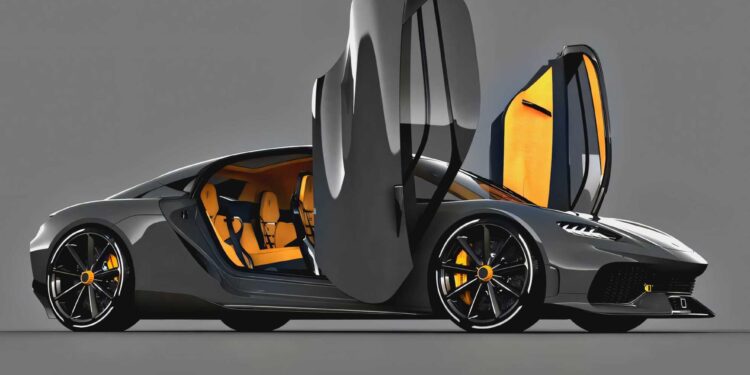Let’s face it: the horsepower wars will never end, and in 2025, that battle continues to wage, with a new breed of highly innovative automakers relying on new technologies, now entering the ring to join the usual crop of traditional names that we often associate with high-performance supercars and hypercars. That quest for even greater speed and larger numbers has yielded an incredible lineup of machines, shaped by cutting-edge production techniques, wrapped in evocative materials, aerodynamics, and defined by extreme design.
This year’s most powerful cars are coming to us from all corners of the globe, ranging from pure-electric, half the cars on this list, to exotics that blend hyper-advanced electric powertrains with the latest in internal-combustion technologies. These are not concept cars, and they’re not vaporware, but machines that are production-certified, VIN-stamped, and (technically) road-legal. While this may be a constantly evolving space, as of mid-2025, here are the 10 most powerful production cars, period.
10. Czinger 21C Blackbird Edition
1,350 Horsepower

The 21C Blackbird Edition is Czinger’s most aggressive interpretation of its 3D-printed hybrid hypercar formula and is a nod to the iconic Cold War stealth reconnaissance aircraft, the SR-71 Blackbird. It debuted in August 2023 at the Quail and doubles down on downforce and track-focused performance. While it packs the same core powertrain as the standard 21C and 21C V Max, a mid-mounted 2.88-liter twin-turbo V8 paired with a pair of electric motors with 1,350 horsepower and 1,033 pound-feet of torque, every surface and aero element has been further sculpted and refined to generate massive grip and cornering performance. Built at Czinger’s Los Angeles facility, the Blackbird leverages cutting-edge additive manufacturing, AI-optimized engineering, and motorsport-derived packaging to bring everything together.
The carbon chassis also integrates a unique tandem seating, placing the passenger behind the driver for a narrow, aerodynamically efficient profile. The rear wing and aero fins work with the underbody to plant the car at speed and provide up to 4,400 pounds of downforce at 190 mph, with 0-60 mph in 1.9 seconds and a top speed of 253 mph. With just 80 examples planned, only 4 of which are Blackbirds (all sold out), this $2.8 million exotic is a highly unique and rare demonstration of what’s possible when engineering innovation meets obsessive performance engineering. Beyond the numbers, the 21C also represents a shift in how hypercars are designed, engineered, and assembled in the modern age.
Czinger 21C Blackbird Specs
| Specification | Value |
| Engine Displacement | 2.88L |
| Engine Configuration | Twin-Turbocharged V8 + 2 electric motors (hybrid) |
| Horsepower | 1,350 hp |
| Torque | ~1,033 lb-ft (combined, estimated) |
| Transmission | 7-speed automated sequential |
| Curb Weight | ~2,900 lbs (estimated with aero package) |
| 0–60 mph | 1.9 seconds (claimed) |
| Top Speed | ~218 mph (high-downforce configuration) |
| Production Number | 4 units (exclusive Blackbird variant, part of a total 80-car run) |
9. Koenigsegg CC850
1,385 Horsepower
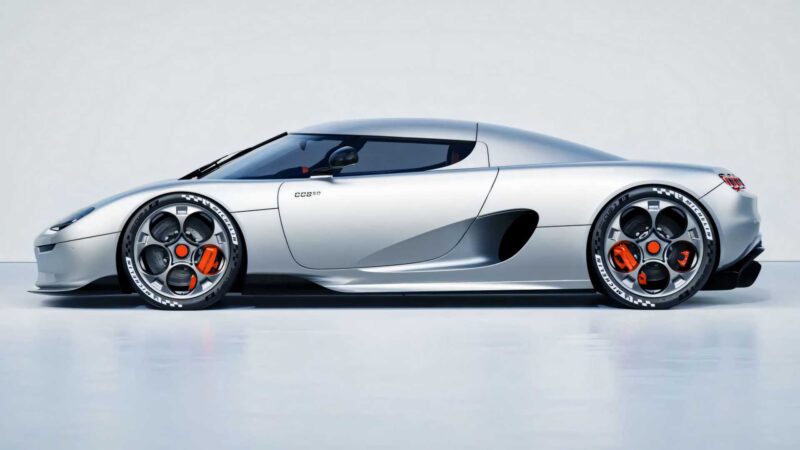
The Koenigsegg CC850 is truly a class act of blending old-school analog thrills with bleeding-edge engineering and tech. Inspired by the Swedish supercar maker’s original CC8S from 2002, the CC850 wears its heritage proudly, while retaining the basic form of the early Koenigsegg design language but with a modern twist. Beneath the surface, though, it’s a thoroughly advanced machine. Power comes from the Jesko-derived 5.0-liter twin-turbocharged V8, which pushes out 1,385 horsepower on E85 and 1,022 pound-feet of torque. But what truly sets the CC850 apart in this company is Koenigsegg’s revolutionary Engage Shift System (ESS). Even though it’s all electronically controlled via the brand’s Light Speed Transmission, it mimics a gated six-speed manual with a physical clutch pedal.
That means the gearshifts should feel fully mechanical, giving drivers the satisfying engagement of rowing gears, but with the underlying flexibility of an advanced multi-mode gearbox. Outside of Porsche’s Carrera GT, there are not many modern exotics that offer a stick. Serving as a tribute to both its 20th anniversary and Christian von Koenigsegg’s 50th birthday, Koenigsegg originally planned 50 examples, but is limiting production to 70 units worldwide. For purists who still crave the connection of a manual at the extreme end of the supercar spectrum, the $3.65 million CC850 may very well be the most analog solution out there.
Koenigsegg CC850 Specs
| Specification | Value |
| Engine Displacement | 5.0L |
| Engine Configuration | Twin-Turbocharged V8 |
| Horsepower | 1,185 hp (on standard fuel) / 1,385 hp (on E85) |
| Torque | 1,022 lb-ft |
| Transmission | 6-speed manual / 9-speed Light Speed Transmission (LST) |
| Curb Weight | ~3,250 lbs |
| 0–60 mph | 2.5 seconds (estimated) |
| Top Speed | 280+ mph (estimated) |
| Production Number | 70 units |
8. Bugatti Tourbillon
1,800 Horsepower
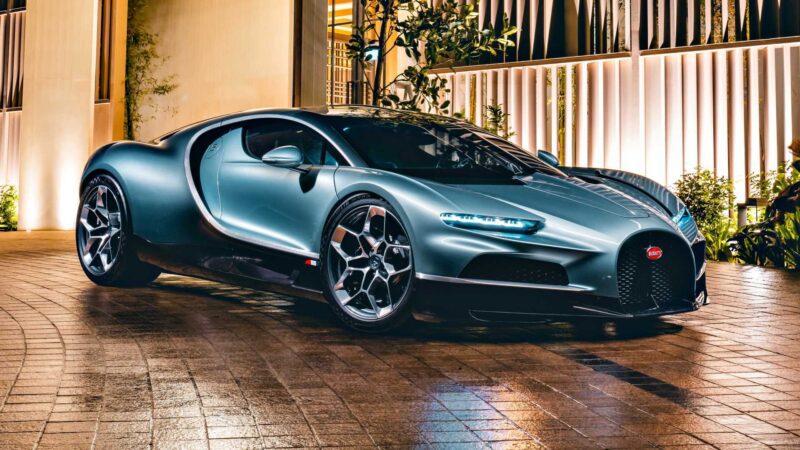
The Bugatti Tourbillon marks a radical departure for the storied French marque. Gone is the iconic Pïech/Veyron-era quad-turbo W16, and in its place, a completely new 8.3-liter naturally aspirated V16, engineered in collaboration with Cosworth. Paired with three electric motors, two on the front axle and one at the rear, this hybrid supercar has a combined system output of 1,800 horsepower. The exact torque figure hasn’t been revealed yet, but the gas unit alone produces 664 pound-feet.
The name “Tourbillon,” borrowed from haute horology, is no accident, and nowhere is that more evident than in the cabin, where digital truly meets analog. There are no screens (besides a small unit that deploys from the center console); instead, physical gauges, milled aluminum toggles, and intricate components create a sense of permanence rarely seen in modern hypercars. The gauge cluster, in particular, is a thing of beauty and will remind you of the watch world. The Tourbillon is a statement that Bugatti can embrace the future while preserving its mechanical soul. Production will be limited to 250 units, with a starting price of $4.1 million and first deliveries slated for 2026. With Mate Rimac now at the helm, expect big things from what is essentially the next chapter of Bugatti.
Bugatti Tourbillon Specs
| Specification | Value |
| Engine Displacement | 8.3L |
| Engine Configuration | Naturally Aspirated V16 + 3 Electric Motors (Hybrid) |
| Horsepower | 1,800 hp (1,000 hp ICE + 800 hp electric) |
| Torque | TBD (Estimated over 1,600 lb-ft combined) |
| Transmission | 8-speed dual-clutch automatic |
| Curb Weight | Estimated ~4,300 lbs |
| 0–60 mph | <2.0 seconds (projected) |
| Top Speed | 276+ mph (electronically limited) |
| Production Number | 250 units |
7. Hennessey Venom F5
1,817 Horsepower
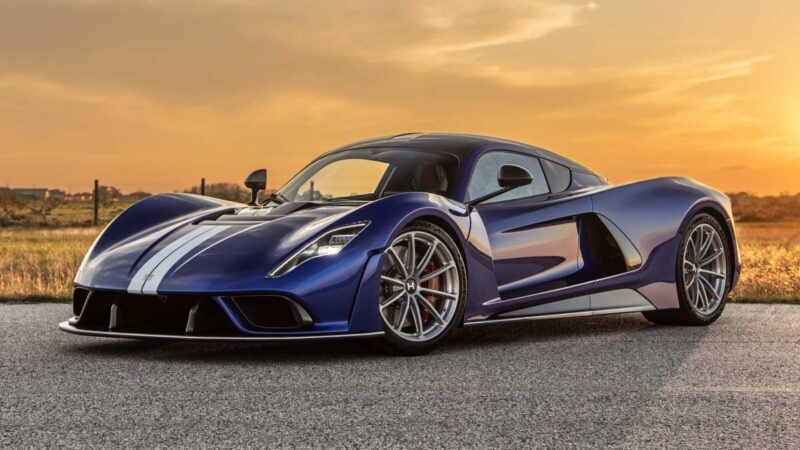
The Venom F5 is Hennessey’s no-holds-barred attempt to build the world’s fastest car. Built in Sealy, Texas, this carbon-bodied supercar is powered by a 6.6-liter twin-turbo V8 named “Fury,” and puts out 1,817 horsepower and 1,193 pound-feet of torque. All of it goes to the rear wheels through a 7-speed single-clutch automated manual gearbox. There’s no hybrid system here, no electric motors, just good old internal combustion pushed to the limit
The numbers are staggering. 0–60 mph takes less than 2.6 seconds, and the top speed? Hennessey is targeting over 311 mph, which would make it the fastest production car on the planet and faster than the 304 mph Chiron Super Sport. To keep the car stable at those speeds, the F5 features a rigid carbon fiber monocoque that weighs only 190 pounds, paired with active aerodynamics and adjustable suspension. The dry weight comes in at just 2,990 pounds, which is incredibly light for a car with this much power. In fact, it is the lightest car on this list and has the best power-to-weight ratio, at 0.61 hp/lb. Priced from $2.7 million, only 24 coupes and 30 roadsters will be built. Only 24 coupes and 30 roadsters will be built.
Hennessey Venom F5 Specs
| Specification | Value |
| Engine Displacement | 6.6L Twin-Turbo V8 |
| Engine Configuration | Twin-Turbocharged V8 (dubbed “Fury”) |
| Horsepower | 1,817 hp |
| Torque | 1,193 lb-ft |
| Transmission | 7-speed single-clutch automated manual |
| Curb Weight | ~3,000 lbs |
| 0–60 mph | <2.6 seconds (estimated) |
| Top Speed | 311+ mph (targeted) |
| Production Number | 24 Coupes, 30 Roadsters, 24 F5 Evo |
6. Pininfarina B95
1,877 Horsepower

Now, onto the very first EV on our list. The B95 is Italian coachbuilder Pininfarina’s most extreme creation to date. The world’s first open-top electric hypercar with no roof, no windshield, and 1,874 horsepower available at your right foot. Built on the same Rimac-sourced quad-motor platform as the Battista, the performance remains ludicrous, drawing power from a 120 kWh battery pack and an estimated 300 miles of range. But only here, you will feel it, as the B95 is Pininfarina’s vision of a modern Barchetta, blending retro cues with dramatic, futuristic lines. 60 mph comes up in under two seconds, and the top speed exceeds 186 mph, with nothing shielding the driver from the rush of air except a helmet and a deployable aero screen.
The body is sculpted for aerodynamic efficiency, with active aero elements and cooling vents designed to maintain performance under sustained loads. Twin carbon fiber flying buttresses separate driver and passenger, giving the cabin a cocooned, fighter-jet feel. Every material inside the cockpit is bespoke, with evocative textures, contrast stitching, and precision-finished metal elements. Pininfarina is also applying advanced manufacturing techniques like additive manufacturing and carbon composite layering to keep the structure of this high-performance EV as light and rigid as possible. Priced from $4.8 million, only 10 examples will be made worldwide.
Pininfarina B95 Specs
| Specification | Value |
| Engine Displacement | N/A (Fully Electric) |
| Engine Configuration | Quad-Motor Electric (Rimac-sourced) |
| Horsepower | 1,877 hp |
| Torque | 1,741 lb-ft (estimated, based on Battista) |
| Transmission | Single-speed, direct-drive |
| Curb Weight | ~4,800 lbs (estimated, similar to Battista) |
| 0–60 mph | <1.9 seconds (estimated) |
| Top Speed | 186 mph (electronically limited) |
| Production Number | 10 units |
5. Pininfarina Battista
1,877 Horsepower
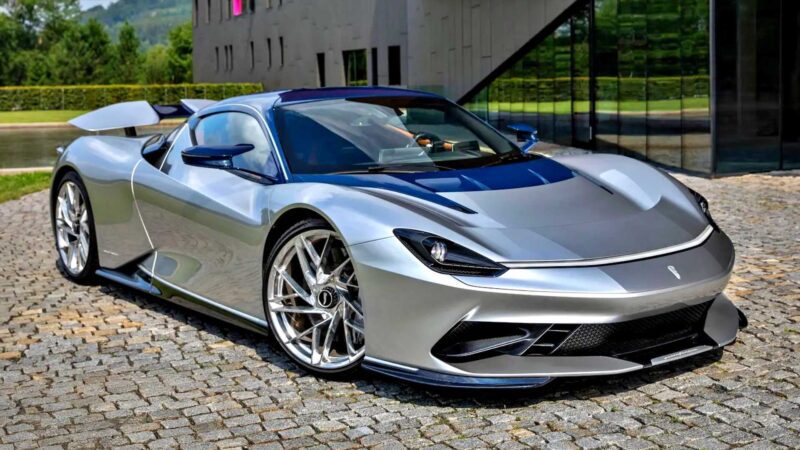
Just like the B95, the Pininfarina Battista is also a Rimac-powered supercar wrapped in coach-built Italian couture. Built in Cambiano, Italy, it also borrows the Nevera’s quad-motor drivetrain, but reimagines it as a luxury GT hypercar. The result is 1,800 horsepower and a 0-60 mph time of 1.79 seconds, wrapped in a curvaceous carbon body. While this is a grand touring hyper EV, shaped by wind tunnels, the design is more reminiscent of something that could have only come out of Italy. It is worth noting that this was also Pininfarina’s debut as a manufacturer.
The carbon-fiber monocoque forms the structural backbone of both the Battista and B95, offering extreme torsional rigidity while keeping overall weight low for an electric vehicle in this power class. It integrates crash structures, battery housing, and mounting points for the quad-motor setup. This lightweight core is key to both high-speed stability and cornering agility. Inside, it’s all bespoke materials, crisp displays, and tasteful flourishes. Both also pack the same 120 kWh battery pack, which translates to 300 miles of driving range. Production is capped at 150 examples, each highly customizable, and prices start at $2.2 million. If the Rimac Nevera is the tech-forward hyper EV, the Battista is its fashionable sibling, with the same bones but wildly different in character.
Pininfarina Battista Specs
| Specification | Value |
| Engine Displacement | Fully electric (4 motors) |
| Engine Configuration | Quad-motor AWD (Rimac-sourced) |
| Horsepower | 1,877 hp |
| Torque | 1,726 lb-ft |
| Transmission | Single-speed (direct drive) |
| Curb Weight | ~4,800 lbs |
| 0–60 mph | 1.79 seconds |
| Top Speed | 217 mph |
| Production Number | 150 units |
4. Lotus Evija
1,972 Horsepower
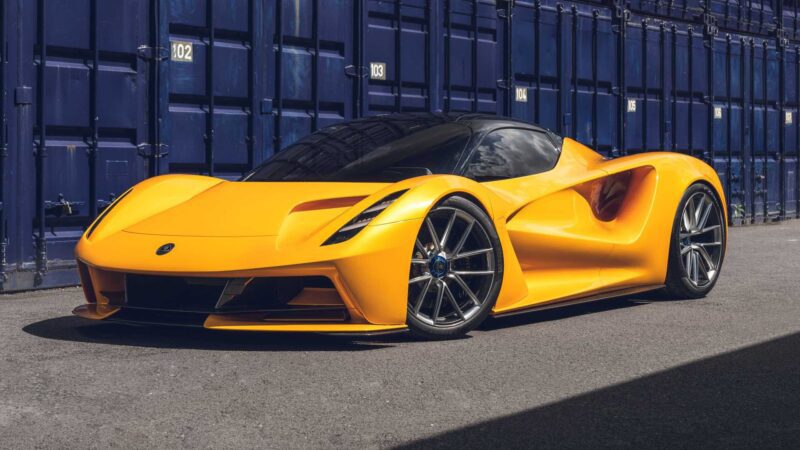
Lotus is a brand that built its reputation on the principles of founder Colin Chapman’s ethos of less is more lightweight engineering, but the Lotus Evija shifts from that philosophy into an entirely new dimension. This is the British marque’s first all-electric hypercar, and it delivers some pretty impressive performance figures: 1,972 horsepower courtesy of four individual electric motors, one at each wheel. That setup allows for precise torque vectoring and instant. Despite a curb weight of around 4,160 pounds, the Evija is plenty quick, with the dash to 62 mph taking under three seconds, and a top speed in excess of 200 mph.
This EV hypercar stays true to Lotus dynamics, as it makes use of a carbon fiber monocoque chassis, advanced active suspension, and adaptive aerodynamics to maintain sharp responses and high-speed composure. The beefy 90 kWh battery sits in the center, aiding weight distribution and lowering the center of gravity, and offers up to 215 miles of range. The bodywork also incorporates functional venting and air channels that help with downforce and cooling, while the cabin pairs minimalist design with race-derived ergonomics. Only 130 examples are slated for production, marking the $2.3 million as both a flagship and a technical showcase.
Lotus Evija Specs
| Specification | Value |
| Engine Displacement | Fully electric (4 motors) |
| Engine Configuration | Quad-motor AWD |
| Horsepower | 1,972 hp |
| Torque | 1,257 lb-ft |
| Transmission | Single-speed (direct drive) |
| Curb Weight | ~3,700 lbs |
| 0–60 mph | <3.0 seconds (claimed) |
| Top Speed | 217+ mph |
| Production Number | 130 units |
3. Aspark Owl
1,984 Horsepower
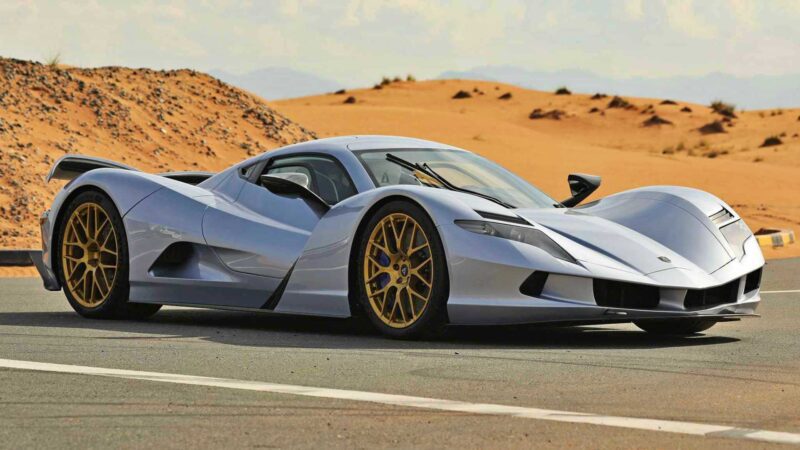
The Owl doesn’t look like anything else on the road. It sits impossibly low to the ground (39 inches), wears a carbon fiber body shaped for minimal drag, and delivers performance figures that rival the best in the hypercar world. Built by Aspark in Japan and assembled by Manifattura Automobili Torino in Italy, the Owl features four electric motors to produce a combined 1,984 horsepower. That’s enough to launch it from 0 to 60 mph in a claimed 1.69 seconds, while top speed is electronically limited to 249 mph. When it was revealed in 2019, it was the world’s quickest and most powerful production car.
Beneath the surface, the Owl rides on a full carbon fiber monocoque chassis that weighs under 265 pounds. Active aerodynamics and a fully adjustable suspension system help maintain stability at speed. The battery pack is a 64 kWh lithium-ion unit, and while range is limited to around 250 miles, the focus here is extreme performance, not practicality. Total curb weight stays under 4,400 pounds, which is impressive for a fully electric hypercar of this size and complexity. Inside, it’s all carbon, Alcantara, and precision-machined aluminum. Aspark is building only 50 units of the $3.2 million Owl worldwide, each hand-assembled and tailored to the buyer.
Aspark Owl Specs
| Specification | Value |
| Engine Displacement | Fully electric (4 motors) |
| Engine Configuration | Quad-motor AWD |
| Horsepower | 1,984 hp |
| Torque | 1,475 lb-ft |
| Transmission | Single-speed (direct drive) |
| Curb Weight | ~4,400 lbs |
| 0–60 mph | 1.7 seconds (claimed) |
| Top Speed | 249 mph (electronically limited) |
| Production Number | 50 units |
2. Rimac Nevera R
2,107 Horsepower
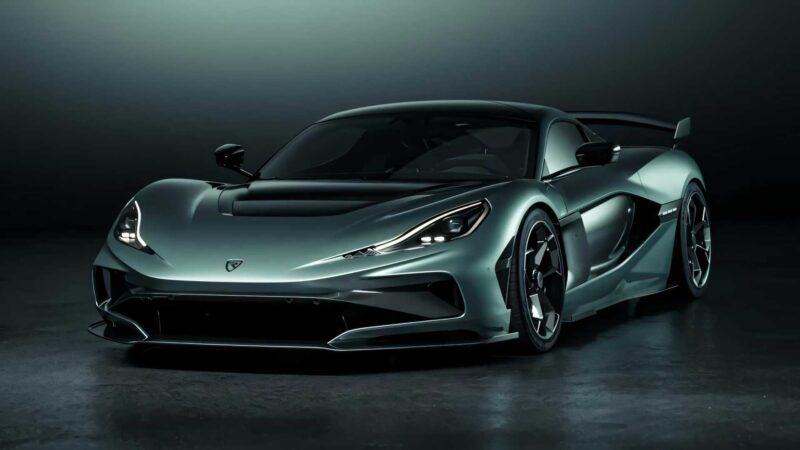
We’re now into the 2000+ hp club. Rimac took the already outrageous Nevera and pushed it even further, to create the record-breaking Nevera R, which delivers a staggering 2,107 horsepower through four independent electric motors, one at each wheel, fed by the same 120 kWh lithium-manganese-nickel battery pack as in the standard Nevera, offering around 250 miles of range and the coefficient of drag is one of the lowest on this list at ~0.3 Cd. But beyond the power upgrade, Rimac also overhauled the control logic, recalibrated the suspension, and introduced lighter materials throughout the chassis and body to create a sharper, more track-focused machine. The result is a hyper EV that hits 60 mph in under 1.8 seconds and passes 186 mph in less than 10. It remains all-wheel drive, but with reworked torque vectoring that responds in milliseconds, the setup is designed to deliver even better levels of cornering grip.
Drivers can fine-tune regenerative braking, adjust front-to-rear torque balance, or let the system adapt in real time. Despite weighing over 5,000 pounds, the Nevera R should handle like a car half its weight. Engineered at Rimac’s facility in Croatia, while the original Nevera proved its immense potential in terms of straight-line speed, the Nevera R takes that narrative further and defies the odds with some serious track potential and, crucially, immense repeatability. Limited to 40 examples, the Nevera R will set you back $2.6 million.
Rimac Nevera R Specs
| Specification | Value |
| Engine Displacement | Fully electric (4 motors) |
| Engine Configuration | Quad-motor AWD |
| Horsepower | 2,107 hp |
| Torque | 1,741 lb-ft |
| Transmission | Single-speed (direct drive) |
| Curb Weight | ~4,740 lbs |
| 0–60 mph | 1.74 seconds (independent test) |
| Top Speed | 258 mph |
| Production Number | 150 units total (Nevera), <20 R variants |
1. Koenigsegg Gemera
2,300 Horsepower
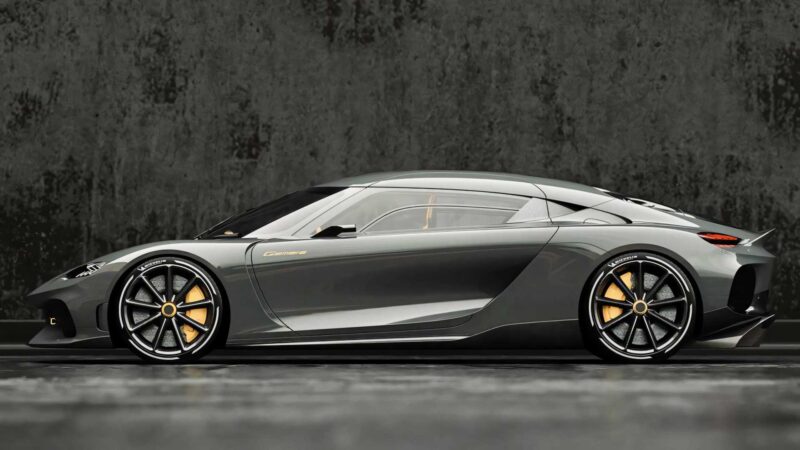
This brings us to the final car on our list, and if you’re a traditionalist, you’re probably relieved that it is internal combustion, that’s leading the charge. The Koenigsegg Gemera began as a revolutionary hybrid GT with a three-cylinder engine. However, it has evolved into something far more aggressive, and the updated version features a twin-turbocharged 5.0-liter V8 that pairs with three electric motors. Combined output stands at a frankly astonishing 2,300 horsepower, making it the most powerful series-production car ever built. The Swedish automaker’s Light Speed Transmission handles gear shifts with no torque interruption. Top speed is claimed to exceed 240 mph. Acceleration figures haven’t been finalized, but Koenigsegg says sub-2.0-second 0–60 mph times are possible.
The car features all-wheel drive, torque vectoring, and a high-capacity cooling system developed for repeated high-load use. The carbon monocoque chassis and active suspension allow for both comfort and extreme stability at speed. The Gemera retains its four-seat layout, expansive cabin, and signature dihedral synchro-helix doors, but underneath, this is a completely reengineered machine. While the production run is far more generous at 300 units, compared to other models on this list, the asking sticker price of $1.7 million also makes it more reasonable. Additionally, with room for four and room for luggage, the Gemera is in essence also the fastest GT car on the planet, that is capable of cross-country touring at warp speed.
Koenigsegg Gemera Specs
| Specification | Value |
| Engine Displacement | 5.0L Twin-Turbo V8 + 3 e-motors |
| Engine Configuration | Hybrid V8 |
| Horsepower | 2,300 hp |
| Torque | 2,028 lb-ft |
| Transmission | Koenigsegg Light Speed Transmission (LSTT) |
| Curb Weight | ~4,079 lbs (est.) |
| 0–60 mph | 1.9 seconds |
| Top Speed | 250+ mph |
| Production | 300 units |

